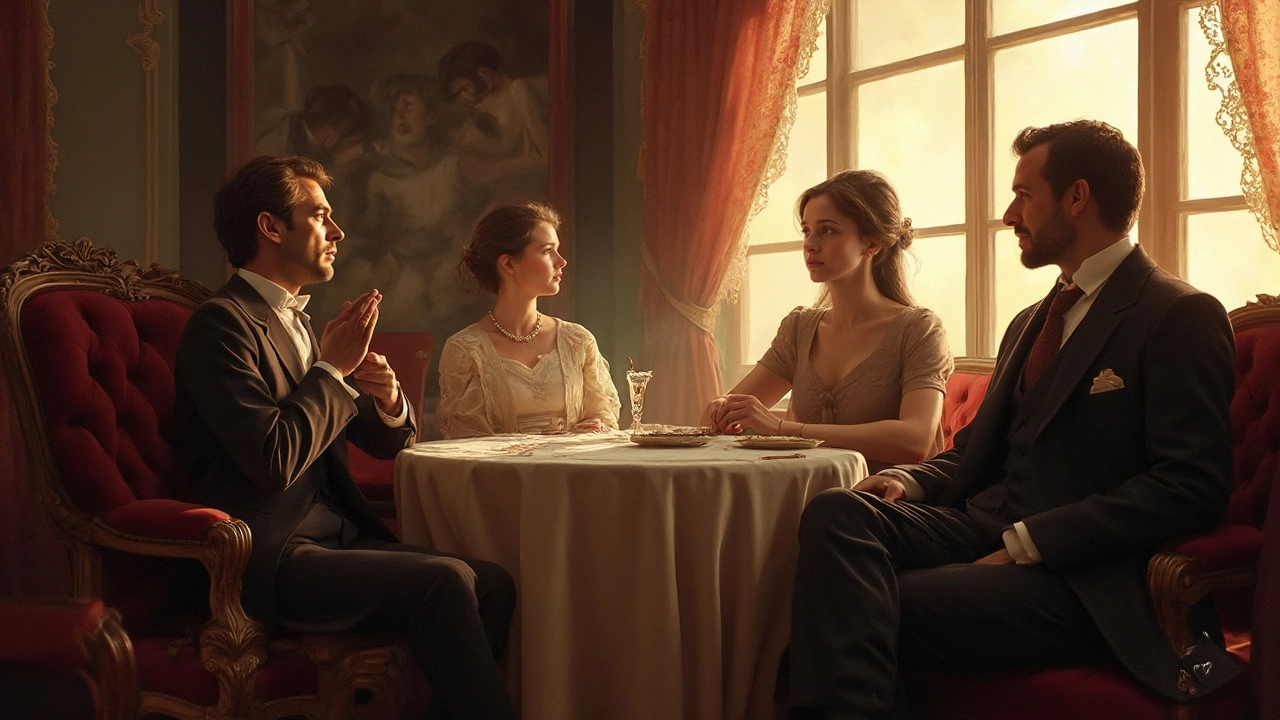
The Titanic is one of those stories that just sticks in your head. Everyone’s seen the movies, heard the tales, maybe even wondered, “Did any actual celebrities die on the Titanic?” It’s not a dumb question. A lot of people think big Hollywood stars or legendary tycoons went down with the ship, but the truth’s a bit different.
The definition of “famous” has shifted over time. Today, we usually picture influencers or actors, but in 1912, famous people were business tycoons, millionaires, and maybe a few artists. The Titanic had more than its share of wealthy and well-known folks, but the list of people you’d recognize from a textbook—well, that’s a lot shorter than you might expect.
Curious? You’re in the right spot. We’ll cut through the rumors, point out the real big names, and show you some wild stories that usually get left out. Plus, if you ever want to spot Titanic myths, you’ll end up with a few practical tricks up your sleeve.
- Who Counts as 'Famous' on the Titanic?
- Real-Life Notable Passengers Who Died
- Myths: Who People Think Died (But Didn’t)
- Titanic in Movies: Mixing Fact with Fiction
- Real Stories Behind the Legends
- Tips for Separating Titanic Truth from Myth
Who Counts as 'Famous' on the Titanic?
When people talk about the Titanic, a common question pops up: Who were the famous people onboard? But “famous” meant something different in 1912. Back then, it was all about money, social status, and your name in the newspaper, not followers on social media. Nobody from Hollywood’s golden age or royalty from across Europe was on the passenger list. But there were some big names from business and society circles.
You won’t find A-list celebrities or chart-topping musicians in Titanic’s first-class manifest. Instead, the ship carried rich businessmen, famous journalists, and a couple of society icons. Think more Fortune 500 than red carpet.
Here’s a quick look at the types of folks people called “famous” back then:
- Business millionaires and industry tycoons, mostly covering finance, railroads, or retail.
- Philanthropists and socialites who made news in their day.
- Top journalists and a few artists or authors, though not many household names today.
According to the Encyclopedia Titanica, “Of the 2,224 aboard, only a handful fit the label of internationally known, and most of those were rich Americans.” Nothing like today’s tabloids.
“The Titanic’s list of celebrated passengers was impressive for its era, but very few would be recognized by the average person a century later.” — Paul Louden-Brown, Titanic historian
So, who exactly made the top list? Here’s a handy table that lists some of the most notable first-class passengers, along with why they were considered well-known in 1912:
| Name | Why Famous? | Status |
|---|---|---|
| John Jacob Astor IV | Real estate mogul, inventor, one of the richest men in America | Died |
| Benjamin Guggenheim | Mining magnate, part of the wealthy Guggenheim family | Died |
| Isidor Straus | Co-owner of Macy’s Department Store | Died |
| Margaret "Molly" Brown | Philanthropist, socialite, later known as "The Unsinkable Molly Brown" | Survived |
| William Thomas Stead | Famous investigative journalist and editor | Died |
If you’re expecting movie stars or sports legends, the ship just didn’t have them. The Titanic’s “celebrities” were measured by old-school standards—money, success, and sometimes, just being in the right social circle.
Real-Life Notable Passengers Who Died
There weren’t any movie stars or kings on the Titanic, but it definitely carried some big names from early 1900s society. None of them had the kind of worldwide fame we see today, but in their circles, everyone knew who they were. Here are a few you’ll keep running into when you dig into the ship’s story.
- John Jacob Astor IV – He was one of the world’s richest men—imagine the Elon Musk or Jeff Bezos of his time, but with even fancier hats. Astor was worth around $87 million (about $2.7 billion today, once you adjust for inflation). He was traveling with his young pregnant wife, Madeleine. She survived, but Astor didn’t make it off the ship.
- Isidor Straus – Co-owner of Macy’s. Straus was a huge figure in retail, and his wife, Ida, is famous for choosing to stay with him rather than get into a lifeboat. Their story showed up in pretty much every Titanic movie, and a bunch of books covered them too.
- Benjamin Guggenheim – Yep, part of that Guggenheim family. He was known for mining and investments, but he gained more attention for calmly accepting his fate on the ship and even changing into eveningwear for the end.
- Major Archibald Butt – Not a businessman, but a key military aide to U.S. Presidents Taft and Roosevelt. He wasn’t world-famous, but he was pretty big in U.S. government circles, and his loss hit Washington hard.
Here’s a quick look at these passengers and why people cared about them at the time:
| Name | Claim to Fame | Net Worth (Modern USD) | Known For |
|---|---|---|---|
| John Jacob Astor IV | Real estate, Inventions | ~$2.7 billion | Wealth, inventions, society personality |
| Isidor Straus | Macy’s co-owner | ~$2 billion | Retail, philanthropy |
| Benjamin Guggenheim | Mining, investments | ~$50 million | Guggenheim family, iconic last moments |
| Major Archibald Butt | Military aide | Unknown | Advising U.S. Presidents |
Some other first-class passengers were big names in their local circles or industries. But if you’re looking for a modern 'celebrity,' these are the closest matches. The Titanic tragedy shocked people because these passengers seemed untouchable—proof that disaster didn’t care how famous, rich, or prepared you were. When you watch movies, recognize that the real stories from that night hit hard not just because of fame, but because people saw these passengers as larger-than-life and still, heartbreakingly, mortal.
Myths: Who People Think Died (But Didn’t)
Ask around about who died on the Titanic, and you’ll probably get a crazy mix of real and made-up names. Over time, stories and Hollywood have convinced people that some truly famous folks were on board when the ship went down—even though they definitely were not.
Let’s clear up some of the biggest mix-ups:
- Winston Churchill – Total legend in British history, but Churchill never set foot on the Titanic. He even wrote about skipping the trip and later called it a lucky choice.
- J.P. Morgan – This American banker owned the company that built the Titanic, so it sounds wild, but he canceled his ticket at the last minute and was nowhere near the wreck.
- Alfred Gwynne Vanderbilt – Big-time New York millionaire, not a Titanic passenger. He died a few years later on the Lusitania, another famous ship disaster.
- Tess of the D’Urbervilles author Thomas Hardy – No connection at all. People confuse him with writers who wrote about the event later.
Movies and books only add fuel to the fire. The 1997 film gave us fictional characters like Jack Dawson and Rose DeWitt Bukater—no trace of them on the passenger list. This blurring of lines is what keeps the Titanic legend so sticky in pop culture.
| Name | Why They’re Rumored | Actual Fate |
|---|---|---|
| Winston Churchill | Rumored as a notable survivor or casualty | Never on board |
| J.P. Morgan | Owned Titanic’s parent company | Canceled trip, lived until 1913 |
| Alfred Vanderbilt | Confused with other millionaires | Died in Lusitania sinking (1915) |
| Jack Dawson & Rose | Main characters in the movie | Fictional, didn’t exist |
So, when someone brings up a legendary figure dying on the Titanic, check the facts. The real list is surprising, and those epic stories? They might be fun, but they aren't history. Whenever you spot a story about a household name dying that night, double-check it—chances are, it’s just another myth wrapped in movie magic.

Titanic in Movies: Mixing Fact with Fiction
If you’ve watched Titanic (the Leonardo DiCaprio and Kate Winslet classic), you probably have a certain picture of what went down on the ship. Hollywood has cemented some ideas in our heads—like the famous bow scene or that big chase with the handcuffs. But how much of what you see on screen is real, and which bits are total movie magic?
Let’s break it down. The movie nailed a bunch of details. The ship’s design, the famous staircase, and plenty of the crew were spot on. The sinking timeline also sticks closely to real survivor reports. Some characters, like Captain Smith and the ship designer Thomas Andrews, were based on real people who really did go down with the ship. In fact, the movie uses real names for several first-class passengers, including John Jacob Astor IV and Benjamin Guggenheim. Both of those men actually were on board—and sadly, they died during the disaster.
But then there are characters like Jack and Rose—totally made up. They pull you into the story, but they never existed. Same for that epic love story with the “draw me like one of your French girls” line. That’s all Hollywood invention. The truth is, no record shows anyone named Jack Dawson on the passenger list, even though there is a real grave marked J. Dawson in Halifax (he was a coal worker, not a romantic lead).
The way the movie shows the lifeboat drama is pretty close, but not every detail matches reality. Some people think the villainous first-class passenger Cal was inspired by real-life folks, but he’s an original character. Also, the famous scene with the band playing as the ship sank really happened, but the exact song they played is still up for debate.
| Movie Character/Event | Real? | Based on? |
|---|---|---|
| Jack Dawson & Rose DeWitt Bukater | No | Fictional, not real passengers |
| Captain Edward Smith | Yes | Real captain, died in sinking |
| John Jacob Astor IV | Yes | Actual wealthy passenger, died |
| Lifeboats weren't enough for everyone | Yes | Historically accurate |
| Ship's band plays until the end | Mostly | Band did play, song debated |
If you want to spot when a Titanic movie is playing fast and loose with the facts, check names against the real passenger list, or see if any wild events make sense outside of a blockbuster script. Stick with real survivors’ accounts for the gritty details—those stories are gripping enough all on their own.
Real Stories Behind the Legends
If you start digging into the Titanic, you’ll bump into all kinds of stories—some real, some made up, some that sound way too wild to be true. But when you break it down, the Titanic was packed more with wealthy business people than with movie stars or royalty. Here are real folks who were well-known in their day and what actually happened to them.
For starters, John Jacob Astor IV was probably the richest guy on the ship. He was an American businessman and basically one of the wealthiest people on the planet in 1912. Astor famously helped his young pregnant wife into a lifeboat before the ship went down. He didn’t make it, but his wife survived and later gave birth to their son.
Another famous name was Benjamin Guggenheim. He was part of the massively rich Guggenheim family who made their fortune in mining. When Guggenheim realized things were really bad, he changed out of his life vest and back into a suit, telling a steward, “We are dressed in our best and prepared to go down like gentlemen.” He, and his valet, stayed behind and died that night.
Isidor Straus and his wife, Ida, were also onboard. Isidor was the co-owner of Macy’s department store. Their story really pulls at you—Ida refused to get in a lifeboat without her husband, and they were last seen sitting together on deck as the ship went down. That’s one of those true love stories people often think only happen in movies, but this one actually did.
Here’s a quick look at the most notable passengers and their outcomes:
| Name | Claim to Fame | Lived/Perished |
|---|---|---|
| John Jacob Astor IV | Real estate, richest passenger | Perished |
| Benjamin Guggenheim | Mining tycoon | Perished |
| Isidor Straus | Macy’s co-owner | Perished |
| Ida Straus | Philanthropist | Perished |
| Molly Brown | Philanthropist, "Unsinkable" legend | Lived |
You won’t find legends like Leonardo DiCaprio’s Jack Dawson on this list because he was made up for the movie. Real stories like Astor and the Strauses tell you plenty about loyalty, courage, and tragedy—and honestly, they outshine the made-up stuff. If you want to spot the true stories behind any “famous” name thrown out with the Titanic, just do a quick search and look for solid sources (avoid chain emails and random Reddit posts). History, in this case, doesn’t need much embellishing.
Tips for Separating Titanic Truth from Myth
Separating facts from myths with the Titanic story isn’t always easy, especially when the lines between real history and Hollywood drama get so blurry. If you want the real scoop on famous passengers or the sinking itself, you’ve got to know where to look and what red flags to watch for.
First up, double-check your sources. Reliable books, museum records, or the official passenger lists are gold. Wikipedia is handy for a quick rundown, but original passenger manifests and survivor interviews dig way deeper.
- If a story sounds wild or too good to be true—like celebs sneaking onto lifeboats—it probably is. Stories get stretched, especially over a century.
- The movie version might give you a recognizable face (like "Jack" or "Rose"), but those characters are fiction. The real Titanic had John Jacob Astor IV, Isidor Straus, and Benjamin Guggenheim as its top headline-makers.
- If you’re stuck, check old newspapers from 1912. Most major deaths were reported within a week of the sinking, and you can still find those archives online.
One common myth is that tons of famous actors or royals were on board. The real ship leaned heavily toward names big in business or society, not Hollywood. Here’s a little comparison just to make it clearer:
| Rumored Famous Passenger | Reality |
|---|---|
| Charlie Chaplin | Never on Titanic |
| Guglielmo Marconi | Was invited, but sailed earlier on the Lusitania |
| John Jacob Astor IV (Titanic millionaire) | Actually died on the ship |
Last tip: if someone drops a dramatic Titanic fact in conversation, ask them where it came from. If the answer comes back as "the movie," or “I saw it on a meme,” it’s a huge clue your BS radar should go off. Stick with real records, and you’ll stay ahead of most of the myths floating around.


